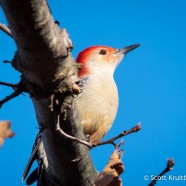Red-bellied Woodpecker
This is one gorgeous bird! It is a male Red-bellied Woodpecker enjoying the warmth of this December weekend, soaking in some sun between feeding on acorns and all sorts of natural food – which seems to be in abundance this season. Between the temperatures in this wonderfully warm stretch of weather and the varied menu to select from it is easy to see why species like this one are able to make a push further north to expand their range. The last two frigid years were an exception to the new warmer-than-average rule, and this incredible positive temperature departure is really going to...
Read MoreRed-bellied Woodpecker
Over the course of Roger Tory Peterson’s lifetime the Red-bellied Woodpecker (Melanerpes carolinus) pushed its typical range much further north, moving into his homes in Jamestown, New York and Old Lyme, Connecticut. This was likely due to a combination of climate change, agricultural areas and grasslands being allowed to mature into woodlands, and humans spreading into suburbs creating additional favorable habitat and feeding birds year-round in their yards. The species can now commonly be found in both of Roger’s favorite locations. This bird is a male, showing his red forehead...
Read MoreRed-bellied Woodpecker
In our continuing discussion of why the birds are named the way they are, here we see the reason for the name behind the Red-bellied Woodpecker (Melanerpes carolinus). Yes, they have a red head, but not as red as some woodpeckers that go by that name. These birds have pushed north over the last several decades, inhabiting new breeding grounds and in many cases year-round territories. In the last couple of weeks I have noted an influx of Red-bellied Woodpeckers, especially in migratory hot spots, showing how some definitely do move north. We can see that red belly thanks to these views...
Read More






